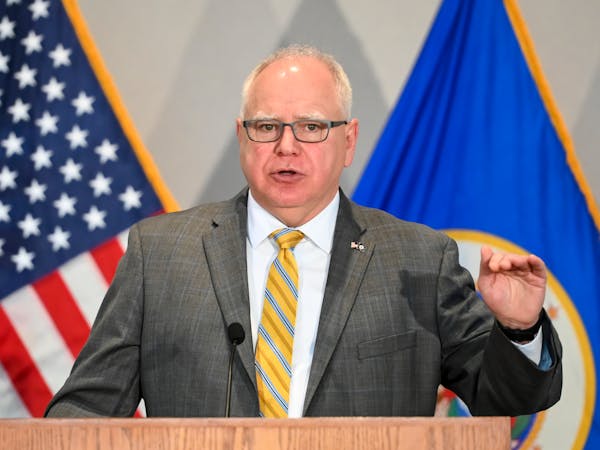Minnesota's COVID-19 vaccination rate of eligible people 16 and older remained just below 60%, but the reporting on Friday of nearly 14,000 more first-dose shots nudged the state toward Gov. Tim Walz's 70% trigger for ending its indoor mask mandate.
The total of 2,628,225 people 16 and older who have received at least a first dose of COVID-19 vaccine left Minnesota 459,179 shots short of reaching that statistical goal.
In announcing the goal on Thursday, Walz said he hoped it would persuade more people to seek shots in exchange for a quicker return to normalcy — though he ultimately pledged to end the mask mandate no later than July 1.
"We can do it awfully fast," the governor said of reaching the 70% goal.
Several restrictions designed to slow transmission of the coronavirus that causes COVID-19 ended at noon Friday, despite some declines in pandemic activity leveling off in Minnesota. The positivity rate of COVID-19 diagnostic testing has dropped to 5.8% from a peak of 7.5% on April 8, but the rate of decline for that key indicator of viral spread in Minnesota has slowed.
The state on Friday reported 12 COVID-19 deaths and 1,453 diagnosed infections, raising the state's pandemic totals to 7,216 deaths and 585,677 known infections.
The newly reported deaths included a Hennepin County resident in the 30 to 34 age range — the 31st COVID-19 death in Minnesota involving someone younger than 35. Only one of the 12 deaths involved a resident of long-term care, a sign of vaccine effectiveness because this vulnerable population was prioritized for initial doses earlier this winter.
Hospitalizations for COVID-19 in Minnesota dropped slightly to 560 on Thursday, but included 144 people who needed intensive care due to breathing problems or other complications of their infections.
Most outdoor restrictions ended at noon Friday, other than a provision of the mandate requiring workers to wear masks if they can't maintain social distancing to do their jobs. Masks also remain required at indoor and outdoor entertainment venues hosting more than 500 people.
"Outdoor events are really pretty open — parades, festivals, gatherings in parks, all these events that are so great about summer," said Steve Grove, commissioner of the Minnesota Department of Employment and Economic Development.
State Health Commissioner Jan Malcolm urged Minnesotans to "keep up our guard" with indoor mask-wearing and social distancing to continue the downward trajectory in pandemic activity on which the latest rollback in COVID-19 restrictions was based.
More vaccination reduces not only the spread of the SARS-CoV-2 virus but its opportunities to mutate into a variant that is more severe or even resistant to vaccine, she said. "That is the very real threat and the very real wild card here. So far, thank heaven, the vaccines have been protective against the major strains that have been circulating. But the more this virus continues to exist and spread the more chance it has to throw off new mutations."
Minnesota's next rollback on COVID-19 mitigations on May 28 will eliminate all capacity caps and social distancing restrictions.
Exactly when the mask mandate will end is unclear. If the state maintains a rate of 15,000 first doses administered per day, Minnesota would hit its 70% goal around June 7.
However, the rate of shots administered has declined in recent weeks despite broad availability and outreach efforts such as mobile vaccine events and onsite clinics in schools.
Walz on Friday announced that state vaccination sites in Mankato, Duluth, Rochester and St. Cloud would now accept walk-in recipients 18 and older. Walk-ins are no longer being accepted at the federal vaccine site at the Minnesota State Fairgrounds, which is now providing scheduled second doses to recipients.
"We want Minnesotans to pile in the car, walk in to a state site and get the whole family vaccinated," Walz said.
Health officials urged Minnesotans to drive the vaccination rate well beyond the incremental goal of 70%, having made earlier predications that a rate of 80% would produce a level of herd immunity that would stifle the spread of the virus.
The state reported that more than 2 million people have completed the one- or two-dose vaccination series. People are considered fully vaccinated 14 days after their final shot.
Jeremy Olson • 612-673-7744

Former MnDOT official approved as Minneapolis public works director

Jury selected for Feeding Our Future trial after unusually long process due to publicity of massive fraud case

911 transcript gives more detail of Sen. Mitchell's alleged burglary
Man shot by deputy in Montrose allegedly said during earlier clash he'd rather die than be arrested

